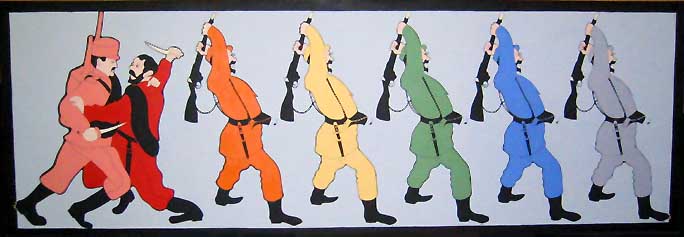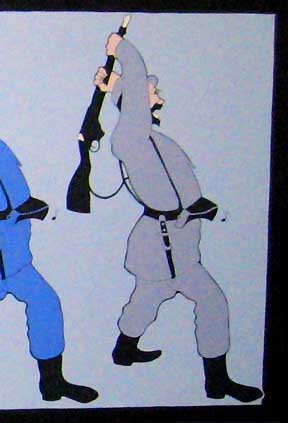
|
||
|
Portland art blog + news + exhibition reviews + galleries + contemporary northwest art
|
||
John Wesley's Battle of Przemysl at PAM  John Wesley's Battle of Przemysl, 1969, 34 x 96 inches One of my favorite works in the Portland Art Museum's permanent collection is John Wesley's simultaneously hilarious and wickedly dark painting, Battle of Przemysl. It's a sphynx like painting that may or may not be making a strange comment on; military expectations, conformity, homoeroticism, politics, the weird ideals of war, wartime music and historical head scratching all in one neat package with a thick black border. That border is not unlike Jo Baer's classic minimalist works, yet this work couldn't be more different than his former wife's work. Instead, it traffics in inference and fetishes the act of stalemate. Also, Battle of Przemysl is ambiguously dry and I like the fact that it is one of Wesley's war-related scenes, not one of his social bon mots (which are good but allow some people to mistake him for being something like a cartoonist in the New Yorker). What is clear is that Battle of Przemysl's composition uses the thick black border to create tension between the purposefully synthetic scene and the impending outcome of the cartoonish military procession (the far right soldier's foot is stepping into the border… breaking the plane and possibly signifying how ideas get tested in the real world). All the while, a pink soldier sneaks up from behind the procession with a knife. Notably, the soldier on the far right is gray, not colorful like the other figures for some reason. So is the gray soldier indicative of an active moment between colorful wartime expectations and even more colorful execution in history? ...the battle did become a movie. Or maybe it's the opposite, the waning gray figure symbolizes a once colorful pre-battle enthusiasm?  Also, Wesley loves obscure title material so one assumes there is a reason he dug this obscure battle up. Historically, in the earlier parts of WWI the Battle of Przemysl was a harbinger of the Russian military's inability to ascertain their enemy's strength and the lurking revolutionary dangers that arose in 1917. Is that a prescient "commie pinko" soldier in hand to hand combat at the back of the line (also sporting a boot that breaks the black border)? Maybe. Was this a Vietnam piece? Maybe. Was Wesley siding with the prevailing strategic paranoia of the time that the communists could strike anywhere and needed to be contained? Maybe, maybe the opposite. Did he consider the ideas and goals of capitalism and communism in confrontation with each other as a way to emerge from constant conflict with a clear winner?… define winner? Wesley's paintings never show a winner or loser. What;s more these rainbow men might be fighting a war, then again they might be lovers… who the hell knows? As I mentioned last week, Wesley doesn't quite fit into any easy art historical taxonomy. He isn't really a; pop, minimalist or surrealist artist but I can see why some try to shoehorn him into those boxes, most art people are attracted to sphyx like ciphers in hopes they can eventually impress themselves. Actually, I think that's what his friend Donald Judd appreciated most about Wesley, he always shows all of his cards… but you'd be damned to tell what kind of deck he's dealing from. Instead, with Battle of Przemysl it's like he deals the viewer a Polaroid of 5 aces and a trivial pursuit card. How do you place a bet when dealt a hand like that? For me Wesley takes Aristotle's edicts about art and ambivalence and has a field day. Sure, Wesley's graphically reduced images on flat canvas planes look like pop art (Ruscha?), the sequential and clean compositions parallel minimalism and there is something deadpan and Magritte-like in his association to surrealism. The only artist he actually reminds me of is Giacometti, whose similarly mute and haunted-ly ascetic work seems like Wesley's more serious older brother. Admittedly, those tangential associations are inevitable but the actual work ultimately repulses all attempts to derive definitive comprehension. Instead, Wesley's paintings are probably what aliens would produce if these hypothetical "space people" decided to stop probing cattle and instead decided to mess with very wealthy art collectors minds. Understanding Wesley is like getting in solid a one-liner in the company of Groucho Marx… it just ain't gonna happen but man is it fun to watch anyone try. Thus, for me…Wesley's art represents a kind of super intelligence that becomes a kind of aesthetic and intellectual horse latitude for mere humans like Dave Hickey or Robert Storr. Each successful painting represents a kind of intense, purposeful stalemate that says yes to everything in order to mean nothing. It's wonderfully existential stuff, presaging Andy Kaufman… or lesser local artist/comedians like Brad Adkins or Joe Macca who both traffic in a similar kind of up front obfuscation in response to the anticipation of anticipation, but Wesley's got more and better art jokes. Wesley also reminds me of Buster Keaton, but he's purposefully less entertaining. Art historically Wesley resembles Andrew Wyeth, Stuart Davis and Francis Bacon… meaning he doesn't resemble anything, he simply stands apart from the hot styles of his day, he's Res ipsa loquitur and essentially alien. Experientially, I liken his best works to those odd scenes in a David Lynch productions… one is left more perplexed after the viewing, yet there is so much clarity when before the scene. Overall, Wesley's work is an inherently idiomatic example of his obscure but highly refined pursuits… so much so I don't really think about the man, just the work. As luck has it Portland's Battle of Przemysl is a very good early Wesley... and though the Prada Foundation retrospective originally sought to include it... their momentary loss is our permanent gain. It is usually on display on the 3rd floor of the Portland Art Museum's Jubitz Center. Posted by Jeff Jahn on June 16, 2009 at 9:12 | Comments (0) Comments Post a comment Thanks for signing in, . Now you can comment. (sign out)
(If you haven't left a comment here before, you may need to be approved by
the site owner before your comment will appear. Until then, it won't appear
on the entry. Thanks for waiting.)
|
| s p o n s o r s |
 |
 |
 |
 |
 |
 |
 |
 |
 |
 |
 |
 |
 |
 |
 |
 |

|
Site Design: Jennifer Armbrust | • | Site Development: Philippe Blanc & Katherine Bovee | |

